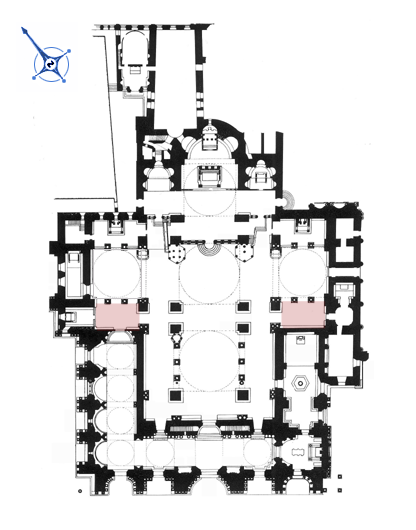 The theme of Mary is announced in the church’s exterior decoration. On the south fa�ade towards the pier, between the crowning arches, the mosaic of the Virgin Praying has been an object of great popular worship, with two lamps lit by night, ever since a merchant who survived shipwreck while sailing from Chioggia to Venice expressed his acknowledgement of the Virgin whom he had invoked. Since then she has been considered protector of the waters.
The theme of Mary is announced in the church’s exterior decoration. On the south fa�ade towards the pier, between the crowning arches, the mosaic of the Virgin Praying has been an object of great popular worship, with two lamps lit by night, ever since a merchant who survived shipwreck while sailing from Chioggia to Venice expressed his acknowledgement of the Virgin whom he had invoked. Since then she has been considered protector of the waters.
The Virgin however is mainly linked to the founding of Venice, which is said to date to Annunciation Day, 25th March 421.
The external portraits are preparatory to seeing the interior where the image of the Virgin is found in a very great number of reliefs, bas-reliefs and statues. There are also two chapels dedicated to her, the Mascoli, with a splendid marble group on the altar and the vault mosaics, and the Nikopeia, the one most venerated by Venetians.
SOUTH TRANSEPT AND NORTH TRANSEPT
The Virgin’s life is appropriately celebrated in two mosaic cycles in two symmetrical orders with a range that is unequalled in West or East: on the west sides of the right and left transept. The mosaics are more or less faithfully based on the apocryphal gospel of James and the Pseudo-Matthew. Here are depicted the Stories of Mary from the announcement of her birth to her death.
The Stories of the Virgin’s life face the mosaics with the Stories of Christ. Mary is the only human worthy of being depicted at the same level opposite Jesus.
The two lives, of Jesus and his mother, have a meeting point arising from the promise made by God to Adam and which has its roots in Jesse. On the bottom wall of the north transept is the Tree of Jesse, at the top of which is the Virgin Mary holding the child, a mosaic dating to the mid 16th century.
MAIN DOOR
Again, in the centre of the narthex above the main door, the Virgin and Child with the Apostles and Evangelists, invites all Christians to cross the threshold of the holy building.
The iconographic image of the Virgin is the Nikopeia: Mary is depicted on foot, frontally with regard to Christ. Her right hand touches Christ’s chest and the other is very close to his left leg but without touching it. Though the child is not supported he is portrayed as if he were seated. His right hand is raised in a gesture of blessing while his left hand holds a parchment resting on his left knee. This representation of the Virgin is pure Byzantine. The Nikopeia is the annunciation of Emmanuel to the Virgin, so the icon represents the incarnation.
Passing the entrance one comes to the Deesis on the portal intrados with the figures of the two greatest protectors of Venice: the Virgin on one side and St. Mark on the other, interceding with the Lord in order that he receive the faithful.
Setting the events of the Virgin’s life in the transept up to her Dormitio in the narthex is not rare in a Byzantine context. The iconographic itinerary follows the scheme of the Byzantine liturgical year which began in September with the nativity of Mary (in the south transept) and ended in August with her death (in the narthex).